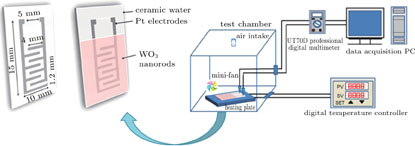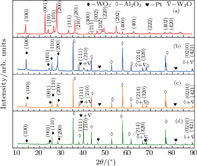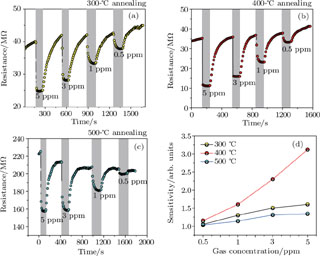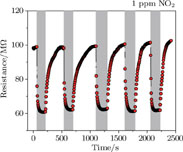† Corresponding author. E-mail:
Project supported by the National Natural Science Foundation of China (Grant Nos. 60771019, 61271070, and 61274074) and the Tianjin Key Research Program of Application Foundation and Advanced Technology, China (Grant No. 11JCZDJC15300).
Hexagonal WO3 nanorods were synthesized through a facile hydrothermal method. The nanorods properties were investigated by scanning electron microscope (SEM), transmission electron microscope (TEM), energy dispersive spectroscopy (EDS), and x-ray diffraction (XRD). The NO2-sensing performances in terms of sensor response, response/recovery times and repeatability at room temperature were optimized by varying the heat treatment temperature of WO3 nanorods. The optimized NO2 sensor (400-°C-annealed WO3 nanorods) showed an ultra-high sensor response of 3.2 and short response time of 1 s to 5-ppm NO2. In addition, the 400-°C-annealed sample exhibited more stable repeatability. Furthermore, dynamic responses measurements of annealed samples showed that all the annealed WO3 nanorods sensors presented p-type behaviors. We suppose the p-type behavior of the WO3 nanorods sensor to be that an inversion layer is formed in the space charge layer when the sensor is exposed to NO2 at room temperature.Therefore, the 400-°C-annealed WO3 nanorods sensor is one of the most energy conservation candidates to detect NO2 at room temperature.
According to the EPA (United States Environmental Protection Agency), NO2 is used as the indicator for the larger group of nitrogen oxides. NO2 is the main source in the production of ground-level ozone and fine particle pollution except for contributing to the formation of acid rain and smog. Therefore, in January 2010, EPA established an additional primary standard for NO2 at 100 ppb, averaged over one hour. In order to detect NO2, many researchers have reported nanostructure metal oxide based NO2 sensors.[1–8] These gas sensors usually were operated at the temperature range of 100 °C–300 °C resulting in high electrical power consumption, which limited the use of the metal oxide based sensor as a sensing element in battery-powered portable devices.[9] Among various nanostructure metal oxide semiconductor materials, tungsten oxide nanorods/nanowires, which can achieve a low operation temperature since WO3 has a lower integrating energy barrier than SnO2 or TiO2,[10–16] are highly promising candidates for detecting NO2. Therefore, it is prospective to develop a low-cost, low power consumption, high-sensitivity and stable NO2 gas sensor based on tungsten oxide nanorods/nanowires.
In most cases, sensing films were prepared by wet chemical methods, so the process of thermal treatment is a necessary step, which not only can burn out the organic solvent used in preparation of coating slurry but also can enhance the adherence between the sensing film and the sensor substrates. More importantly, thermal treatment could stabilize the sensing film's microstructure and then improve the reliability and stability of the gas sensor.[17] However, the gas sensing material would gradually undergo a series of morphological evolutions and obvious changes of phase composition with the increase of temperature. On the other hand, these changes are the main factors which would influence the gas-sensing properties of oxide semiconductor based sensors.[18] Therefore, it is significant to comprehensively understand the relationship between the annealing-induced microstructure changes and the gas-sensing properties of the one-dimensional tungsten oxide.
Next, metal oxides based gas sensors are classified as n-type or p-type according to whether they show a decrease or an increase of conductivity when they are exposed to an oxidizing gas (such as NO2).[19,20] WO3 nanorods sensors which were operated at high temperature are known to behave as an n-type semiconductor.[21–25] The p-type semiconductor based on WO3 nanorods operating at room temperature is rarely reported. Consequently, this paper is focused on the sensing property of WO3 nanorods sensor at room temperature.
In this study, WO3 nanorods are prepared by a facile hydrothermal method and the relationship is investigated between the microstructures and gas sensing properties of WO3 nanorods sensors annealed at 300, 400, and 500 °C, respectively. In addition, the p-type semiconductor gas sensing mechanism of the WO3 nanorods sensor is discussed.
WO3 nanorods were synthesized through hydrothermal technology. In a typical procedure, 0.01-mol Na2WO4·2H2O and 0.02-mol NaCl were dissolved in 60-ml deionized water and stirred for 30 min by magnetic stirring apparatus. Na2WO4·2H2O was served as a precursor and NaCl was used as structure directing agents (SDAs) which have been proven to facilitate the controllable growth of nanostructure WO3. The pH value of the solution was fixed at 2.5 which was adjusted by using 3-M HCl solution. Then, the obtained uniform mixture was transferred into a 100-ml Teflon-lined stainless steel autoclave and heated at 180 °C for 24 h in an electric oven. After naturally cooling down to room temperature, the resultant precipitates were washed with deionized water and ethanol by a centrifuger several times and dried in a vacuum at 80 °C for 10 h. Finally, the slurry of as-prepared tungsten oxide nanorods was prepared by ultrasonically mixing tungsten oxide nanorods and terpineol, which acted as a vehicle binder and solvent. In this experiment, all reagents were purchased from the Guangfu Fine Chemical Research Institute (Tianjin, China).
Firstly, a pair of interdigital Pt electrodes was deposited on the cleaned alumina substrates by RF magnetron sputtering using a shadow mask. In detail, the DPS–III ultrahigh vacuum facing-target magnetron sputtering system was used to deposit Pt electrical contacts and operating parameters were listed as follows: the RF power was 90 W, the base vacuum pressure was 4.0 × 10−4 Pa and the working pressure was 2 Pa. Secondly, the coating slurry was prepared by mixing the nanorods (30 mg) in terpineol (0.2 ml) and then ground in an agate mortar for 30 min to obtain a homogeneous paste. The resulting paste was coated on those alumina substrates by the spin-coating method. Thirdly, the WO3 nanorods sensors were annealed at 300, 400, and 500 °C for 2 h in the air with a heating rate of 6 °C/min, respectively. Then the gas-sensing characteristics of as-prepared sensors were tested in a computer-controlled static gas sensing characterization system which consists of a 30-L sealed organic glass test chamber, a professional digital multi-meter, a data acquisition system and a flat heating plate with an adjustment range from room temperature (RT) to 300 °C.[26] The programmable multi-meter was connected to the data acquisition system, which was used for continuously recording the resistance changes of the sensor and the sampling interval was set to 1 s. The schematic diagram of the sensor and the measurement system are depicted in Fig. 
The morphology, element composition and crystal structure of the WO3 nanorods were characterized using a field emission scanning electron microscope (FESEM, FEI Nanosem 430), energy dispersive spectroscopy (EDS) attached on the FESEM, transmission electron microscope (TEM, TECNAIG2F-20) and x-ray diffraction (XRD, RIGAKU D/MAX 2500V/PC, Cu Kα radiation).
Typical FESEM image of as-synthesized WO3 nanorods is shown in Fig.
The surface morphology of the square-marked area and the corresponding EDS spectrum of WO3 nanorods with annealed samples are shown in Fig.
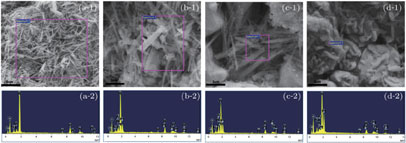 | Fig. 4. (color online) The surface morphology of selected area and corresponding EDS spectrum of (a) WO3 nanorods, (b) 300-°C-, (c) 400-°C-, and (d) 500-°C-annealed samples. |
| Tab1e 1.
|
The elements concentration of (a) the pristine WO3 nanorods together with (b) 300-°C-annealed, (c) 400-°C-annealed, and (d) 500-°C-annealed sensor are illustrated in Table
In order to estimate O elements weight% derived from adsorbed oxygen, we have calculated the O elements weight% derived from other oxide. For example, the relative molar mass of W and O in the WO3 molecule is 184:48. The weight% of W elements is 70.39% in the pristine WO3 nanorods, so the weight% of O elements in WO3 is 18.36%.The results are shown in Table
| Tab1e 2.
|
On the basis of Table
| Tab1e 3.
|
The crystalline phases of WO3 nanorods annealed at different temperatures together with the pristine WO3 nanorods were analyzed by x-ray diffraction. The XRD patterns of the original WO3 nanorods match well with JCPDS NO. 33-1387 for hexagonal WO3 as indicated in Fig. 






We have examined the 300-°C annealed sample by sensing 1-ppm NO2 from room temperature to 250 °C and the sensor showed two completely different sensing behaviors. The WO3 nanorods sensor showed a p-type response at the range of 25 °C–50 °C while an n-type response at the range of 50 °C–250 °C. This work has been published in Ref. [29]. The p-type semiconductor based on WO3 nanorods operating at room temperature is rarely reported. Consequently, this paper is focused on the sensing property of WO3 nanorods sensor at room temperature.
Figure
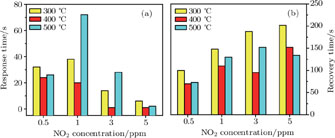 | Fig. 7. (color online) Relationship between (a) the response time (b) recovery time and NO2 concentration for the sensors based on annealed tungsten WO3 nanorods at room temperature. |
 | Fig. 8. (color online) Schematic energy-level diagram of (a) n-type semiconductor, (b) the formation of depletion layer, (c) the formation of inversion layer. |
In a word, from Fig.
When operated at high temperature, tungsten oxide sensors are known to behave as n-type semiconductors. One of the conceivable mechanisms for the p-type conductive behavior at RT is the formation of an inversion layer on the surface of WO3 nanorods. Owing to the fact that bulk defects equilibrate quite slowly at RT, surface conduction is dominant. The surface of the semiconductor is composed of a surface layer and space charge layer. Because of the existence of large density of surface states which mainly was induced by dangling, structural defects and gas adsorption, too many charges accumulated on the surface layer, which led to an aggregation layer, depletion layer, or even inversion space-charge layer below the surface layer of the semiconductor as shown in Fig.
For practical use, the repeatability of the gas sensors is also an important quality factor. Reversible and reproducible responses of the 400-°C-annealed gas sensor upon periodic exposure to NO2 gas of 1 ppm are presented in Fig. 9 with five switching on/off cycles. Notably, the sensor shows a similar response value and response–recovery time, which suggest an excellent repeatability and stability. It is well known that the high crystallinity of the WO3 nanorods is responsible for the high stability of the sensor.[31]
In summary, WO3 nanorods were successfully synthesized through the hydrothermal method. The microstructures and crystalline phases of both pristine and annealed WO3 nanorods were investigated by SEM, EDS, HRTEM, and XRD. The test results showed that a fracture occurred during annealing treatment. The 300-°C- and 400-°C-annealed samples became shorter than the original WO3 nanorods but the 500-°C-annealed nanorods were shaped into nanoparticles. At the same time the XRD patterns indicated that a new crystalline phase W3O came into being during the thermal treatment process. Moreover, the appearance of a low oxidized tungsten phase W3O was beneficial to the enhancement of the gas sensing performance of WO3 nanorods. Response measurements of annealed samples performed at RT showed that all the annealed WO3 nanorods sensors presented p-type behaviors. We suppose the transition mechanism from n to p-type to be that an inversion layer formed in the space charge layer when the sensors were exposed to NO2 at room temperature. Compared with the 300-°C- and 500-°C-annealed samples, the 400-°C-annealed sample has higher response, quicker response/recovery speed, and more stable repeatability. The excellent gas sensing properties can be attributed to its moderate crystallinity, larger specific surface areas and more oxygen vacancy. This result is important for the future research and development of a gas sensor based on hexagonal WO3 nanorods, which favors low power consumption, high sensitivity and integration technology.
| [1] | |
| [2] | |
| [3] | |
| [4] | |
| [5] | |
| [6] | |
| [7] | |
| [8] | |
| [9] | |
| [10] | |
| [11] | |
| [12] | |
| [13] | |
| [14] | |
| [15] | |
| [16] | |
| [17] | |
| [18] | |
| [19] | |
| [20] | |
| [21] | |
| [22] | |
| [23] | |
| [24] | |
| [25] | |
| [26] | |
| [27] | |
| [28] | |
| [29] | |
| [30] | |
| [31] |


